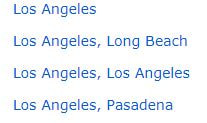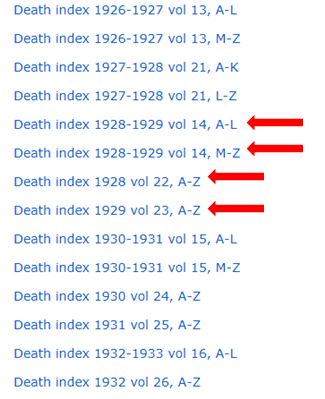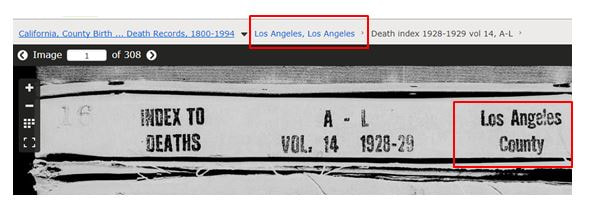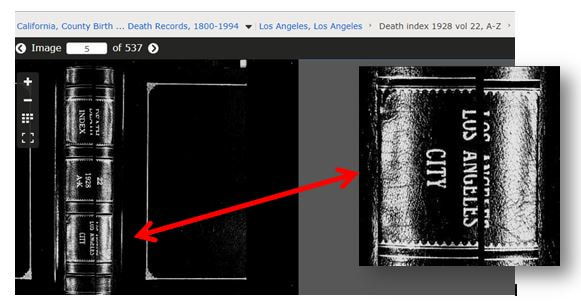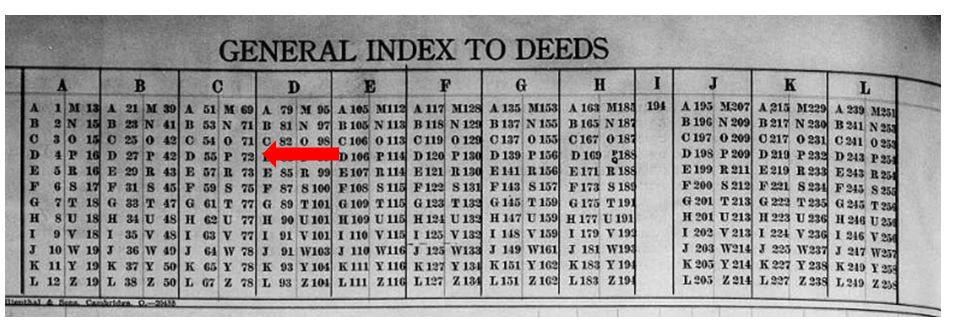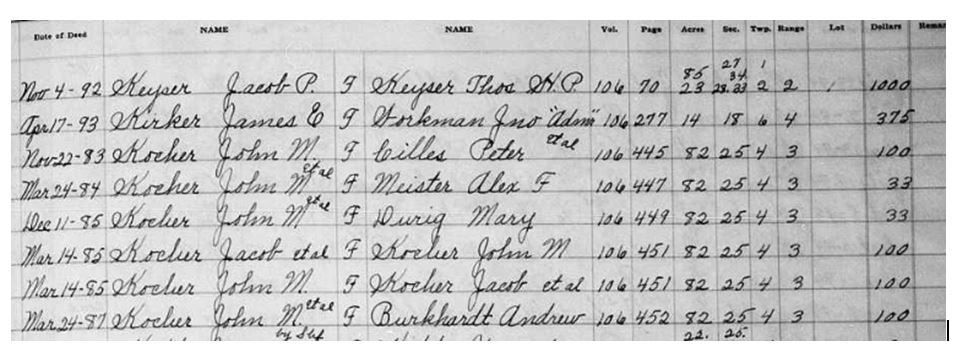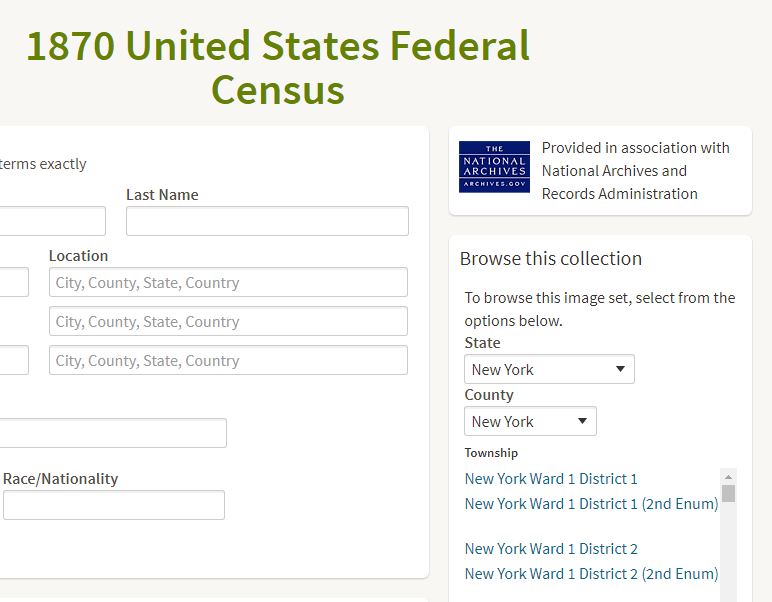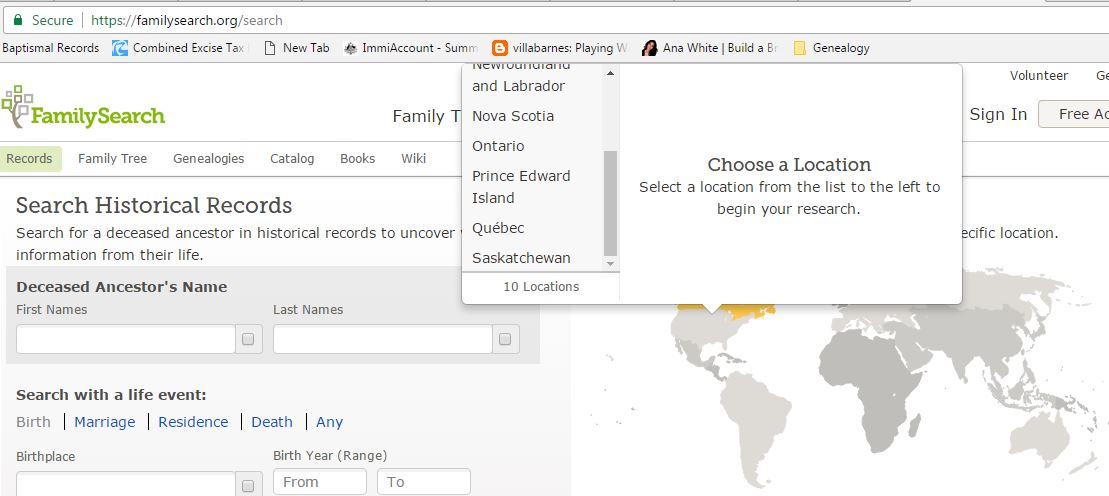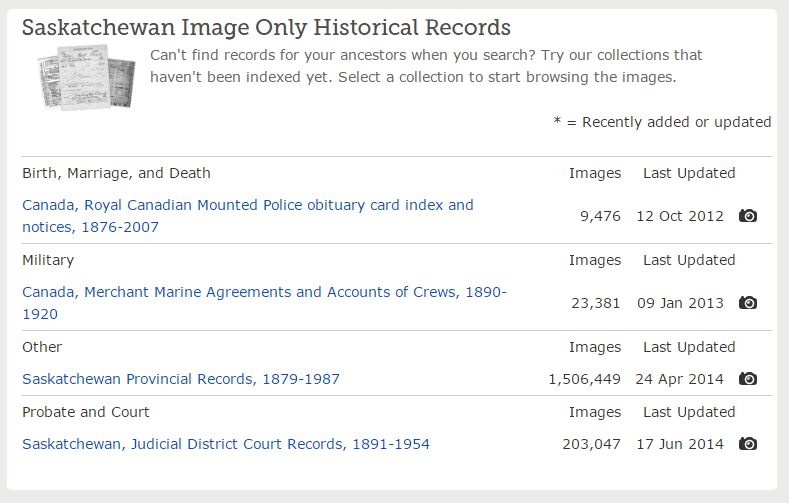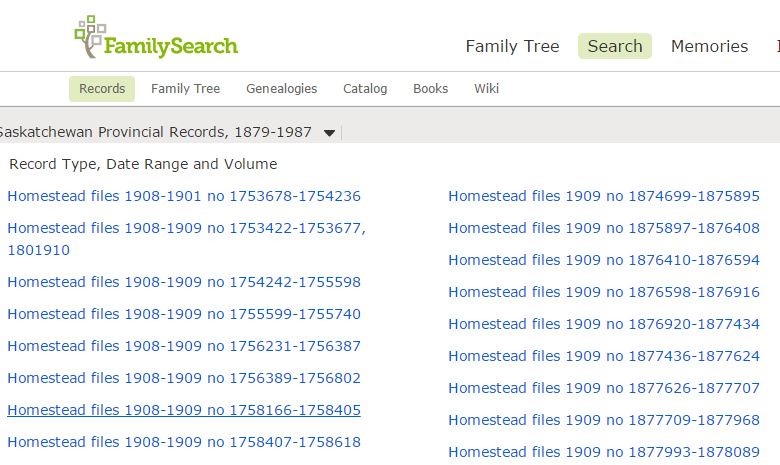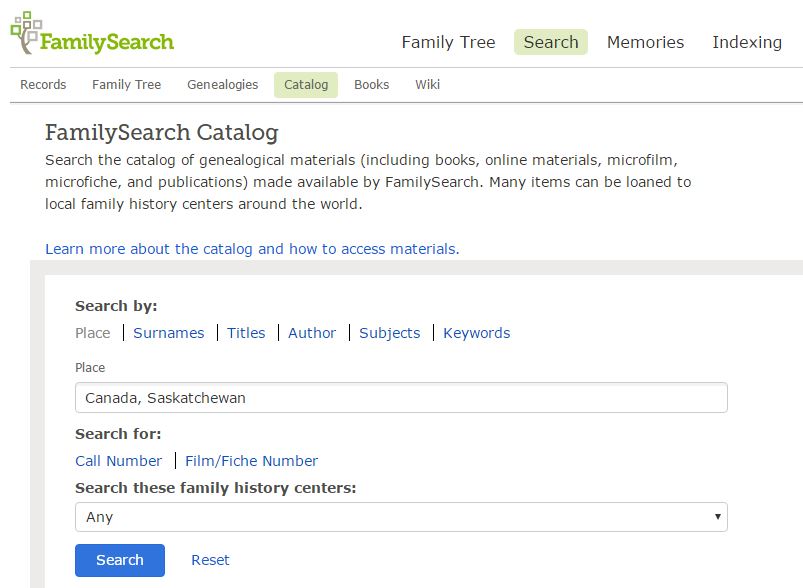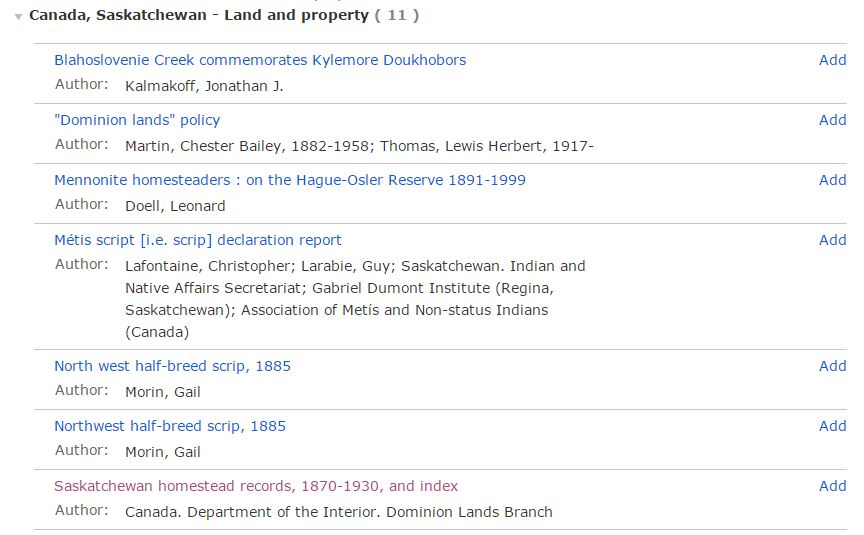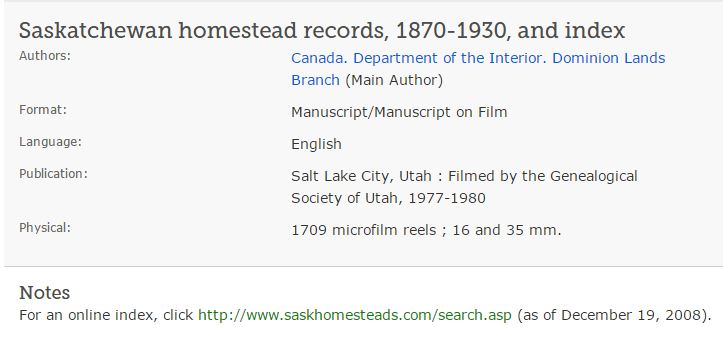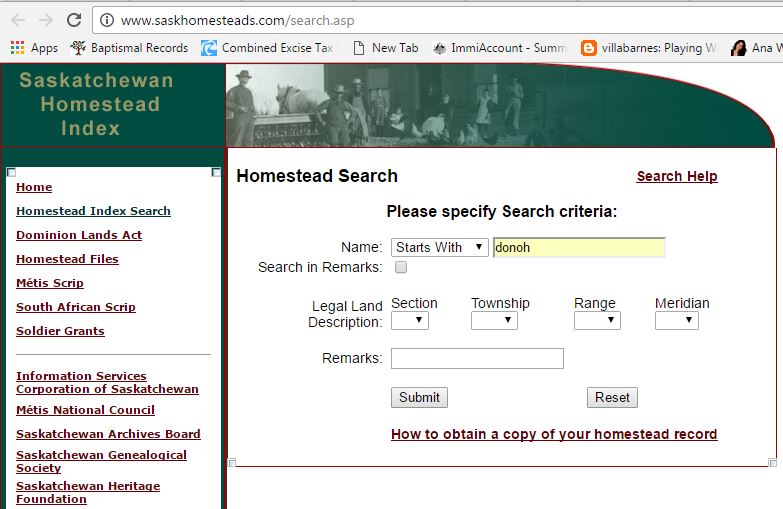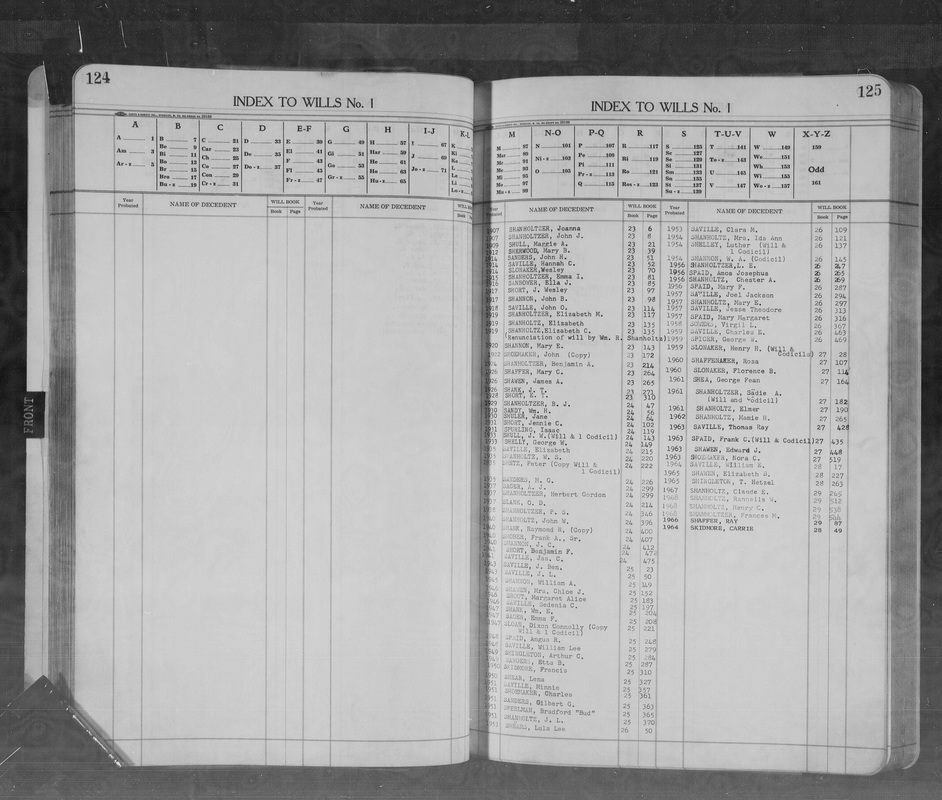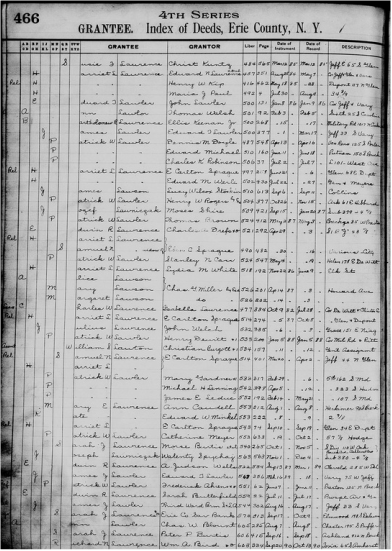|
I love FamilySearch. I love FamilySearch more every day. The records I have been able to find for my family just in the last week have included an 1854 church marriage record from County Durham in England, 1855 and 1857 baptismal records for that couple’s son and daughter, an 1885 Champaign County, Illinois marriage record, a 1931 Pierce County, Washington death certificate and more. I found all those images, for free, in just minutes, all from the comfort of my living room. Every day, FamilySearch adds more images to their vast collection of digitized records, which any researcher, anywhere in the world, can access to learn more about their family. Many of these collections are not searchable by name on FamilySearch, but there are ways to browse the collections of images to find what you want. For example in addition to the volumes of death certificates for the City of Los Angeles, FamilySearch has also digitized the indexes to those volumes. Search for a name in the index volume to find the certificate number, and then look in the film of death certificates to find the actual certificate. But I want to caution you a bit about the indexes. Sometimes FamilySearch puts the index books in the wrong place. What do I mean? Here’s an example. FamilySearch has a wonderful collection, “California, County Birth and Death Records, 1800-1994.” (https://familysearch.org/search/collection/2001287). If you look on the page, you will see search boxes, but when you read the description, you’ll see some limitations – “The name index for death records covers Stockton, Lodi and Manteca cities and San Benito and San Joaquin counties.” If you want records for other counties, scroll to the bottom of this page to where it says “Browse through 2,915,415 images.” When you click on that link, you’ll see a list of counties and towns. Here’s a small portion of that list. “Los Angeles, Long Beach,” “Los Angeles, Los Angeles,” and “Los Angeles, Pasadena” will link you to records for those three cities, while plain old “Los Angeles” will give you records for the County of Los Angeles. On FamilySearch when you drill down and click on the “Los Angeles, Los Angeles” link. Over 700 links will appear, starting with links to Birth Certificates, then Death Certificates, then finally, at the bottom of the list are the Death Indexes. Since these records appear under the title “Los Angeles, Los Angeles, they should be just for the City of Los Angeles. Should be. But this is where the researcher needs to beware. Here’s just one selection from the titles of the indexes: Look carefully and you will see some overlap. “Death index 1928-1929 vol 14, A-L” and the same for “…M-Z.” But the item immediately below that is “Death index 1928 vol 22, A-Z” and then “Death index 1929 vol 23, A-Z.” Same years. Why are they repeated, and why do they have different volume numbers? Here’s what I see when I click on the 1928-1929 volume 14 item: Image 1 of 308 shows the cover of the book, perhaps the most important image in that set. Because, although FamilySearch has placed this digitized item in the “Los Angeles, Los Angeles” section of records, it is NOT for the City of Los Angeles, it’s for LA County. Here is image 5 of the “Death index 1928 vol 22, A-Z”: You can see it says “Los Angeles City” on the spine of the book. If you find a certificate number in Volume 14, the book for Los Angeles County, and then try to look for it in the City of Los Angeles death records for 1928, it won’t be there. You’ll find whosoever's LA city death certificate has that number. Be sure to look at the image of the spine of the book of records you're to see what it covers before you go diving into the index! And the second issue is that when you look at plain old Los Angeles County, you won’t see an index to the LA county death certificates… because FamilySearch has incorrectly placed the index for the county under the “Los Angeles, Los Angeles” title. I have alerted FamilySearch to this issue and hopefully they will correct it soon. This is just one instance of digital images being put in an incorrect location on FamilySearch. I know that there are probably a few more. If you don’t see what you expect to see, dig a little deeper, look at the images of the book covers, and see if you can figure out where the image you’re looking for might be. With all the great documents FamilySearch give me, this researcher is OK with having to beware and dig a little deeper once in a while.
2 Comments
Counties across the country use different methods to index their deeds, probates, naturalizations and other records. They are generally based on some alphabetical combination. It may be as simple as using separate sections of the index book for each surname that begins with a particular letter. All the grantors whose surnames begin with “A” are listed in order of when they recorded the deed. Or it might be a more complicated arrangement using two or three letters in the surname, perhaps combined with the first letter of the given name. FamilySearch continues to digitize more records, making available record images that are not searchable by name and can only be browsed. But if you know how to use these county level indexes, you should have no trouble locating your ancestor in these valuable records. I’ve written before about the Graves Tabular Initial Index and a West Virginia will index. I’ve been working on a presentation on the ins and outs of indexes for the Lewis County Genealogical Society next month, so I thought I’d write about using another indexing scheme. Most counties I have run across have a set of Grantor indexes listing people who sold (or otherwise transferred) property, along with a similar set of Grantee indexes for people who purchased property. But Belmont County, Ohio combines the two into one set of books. How does that work? To start with, you need to know the surname and first name of the party you are interested in. You can access the deed indexes for Belmont at https://familysearch.org/search/catalog/247145. Across the top of each page in the Deed Index for Belmont is a chart. The first letter of the surnames are listed across the page, and beneath each of these letters are the 26 letters corresponding to the first letter of the given name. Next to each of these letters is a page number where you will find that Last Name/Given Name combination listed. Here’s the chart shown at the top of all the left-hand pages in the books: I should find any transactions for Peter Cilles on page 72. And when I go to page 72, here’s what I see for Peter: You can see that there are 2 columns with names. The index only applies to the first column. Between the two “Name” columns is a narrow strip with either “to” or “F” (for “From”) recorded. In the first entry, Peter Chilles et al are transferring property TO Jno. M. Korcher. In the third entry, P. R. Cook et al are acquiring property FROM Mary Smith et al. Looking to the right we can see the volumes and pages where we can find the actual deeds (and get some idea who theses “et al” others actually are.) The index also gives a very brief description of the property, showing the number of acres, the Section, Township and Range where the property is located and what the transfer price was. In this case Peter Cilles is my person of interest, and I now have all the information I need to find his deed. If Jno Korcher was my guy, the letter table above would point me to find the corresponding entry in the same book on page 225. The transaction with Peter Cilles is the third one down, but you can see that John Korcher acquired a number of pieces of property in Section 25 around that same time. This kind of index is an efficient way to search. You can find all the transactions for your ancestor for a given time span, both buying and selling, all in the same book. Happy hunting! I recently presented “Censational Census Strategies” for Legacy Family Tree Webinars. In it, I mentioned the second enumeration to the 1870 census. The 1870 census is purported to be the worst US census ever taken.[1] There were enough people missed and enough errors that a second enumeration was ordered for a few large cities, including New York City. This second enumeration was taken in January of 1871. How can you find this second enumeration? If you have an Ancestry.com subscription, you can do a search for the 1870 census. Once you get there, on the right side of the screen you will see "Browse this collection" and you can specify your state (NY) county (NY) and then use the dropdown for the town and you will see something like: “New York Ward 1 District 1,” then ”New York Ward 1 District 1 (2nd Enum).” You can then browse through the pages. However, you may not know the Enumeration District (ED.) If you don’t have an Ancestry.com subscription, you may have access to HeritageQuest databases from home using your library card. This is one of the databases many libraries provide to their patrons, for free, from home. Look on your library’s website for something like “Research“ or “Databases” and then for a Genealogy or History category. Again, if you don’t know your ancestor’s ED, this might not be so useful. I would suggest you just do a straight up name search for your ancestor, and try to find them on both enumerations. If you can only find them on one, pick 3 or 4 neighbors on that enumeration, and then look for them on the other enumeration, and see if you can't find your ancestor. Hope that helps! [1] http://stevemorse.org/census/1870secondenumeration.html Both. No question. Both. Why? Because sometimes one way into the records will have a hint or a clue, or maybe even an index that’s not available when approaching the records from another direction. Take for example the Saskatchewan Provincial Records. If you go into FamilySearch through the Search page, click on the map for Canada and select “Saskatchewan” you can scroll to the bottom of the page to see the “Unindexed Records.” These are browseable records. There are thousands of images of records, maybe even the homestead record of your ancestor, but unless you have the date the homestead claim was recorded, or better yet the claim number, good luck. You will find yourself searching through file after file looking for a needle in an entire province of haystacks if you start your search using the map. But if you click on FamilySearch.org/Catalog/Search, type “Saskatchewan, Canada” into the search box, and scroll down to “Land and property,” you’ll find “Saskatchewan homestead records, 1870-1930, and index.” An index! Yes, it’s an external index that will take you out to http://www.saskhomesteads.com/search.asp. But that index will lead you to the file number for your ancestor’s homestead record. The Saskhomesteads website provides a link where you can purchase a copy of the file, but once you know the file number, just go back into the “Land and property” in the Saskatchewan page in the FamilySearch catalog and browse through the records for that file number. 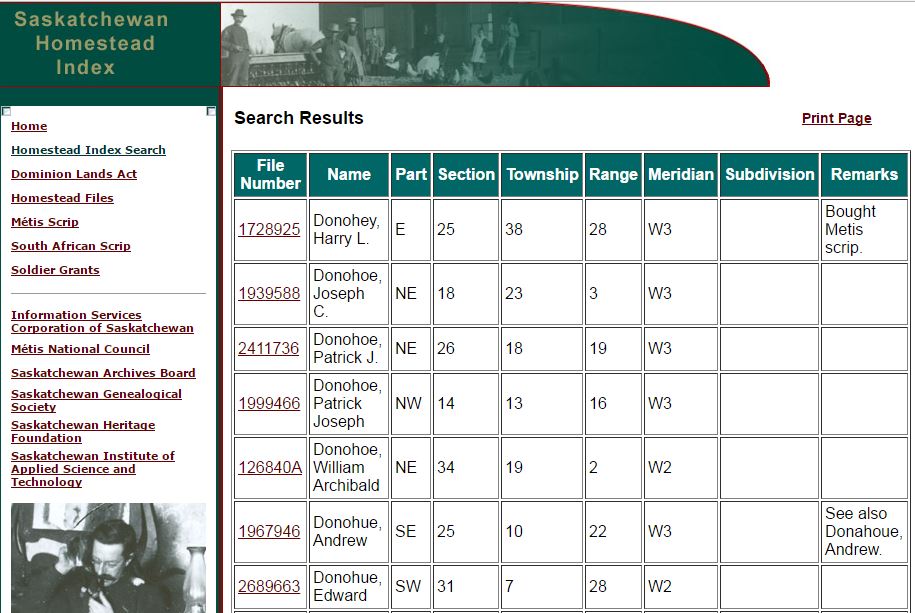 Here's a partial list of results from my search. The numbers to the left of the names refer to the homestead file numbers. I can go back to that list of Saskatchewan Provincial Records we saw earlier and see if FamilySearch has the file I'm looking for. If not, I can order it from the Saskatchewan Homestead Records site. The map search is quick and easy to get into, just “point and shoot,” but sometimes it doesn’t have all the tools. Be willing to explore the catalog and its PlaceName search to see if that might offer a more helpful way into the millions of unindexed records on FamilySearch. For my Tuesday Tips today, I'll cover another indexing scheme for organizing the names you might find in a county record book. These books cover things like wills, deeds and more. As FamilySearch.org puts up more and more image-only historical records, it's important to understand how the indexes work. The records on FamilySearch aren't necessarily searchable via search boxes, but if you know how the indexes work you can find them almost as quickly. as you could with search boxes. West Virginia Will Index – The example below is from FamilySearch for West Virginia Will Books, 1756-1971 Hampshire Index to wills, v. 01 1907-1969 You can see the index above across the top of every page, they list the letters, so even on the A names pages you can see the S index pages. But let’s look at this. There is S on page 125. Sc is 127. Se is 129, etc. But note this is NOT a straight up alphabetical index. Page 125 is not just the names beginning with Sa and Sb. Page 125 displays the S+ the letters that aren’t specified. So things like Sa, Sh, Sp, Sl. Whoever put this index together for the county saw that there were a lot of SC names, a lot of SM, ST, etc. so those letter combinations got their own pages. There aren’t so many SA-, SP- and SH- surnames so those names have been combined on their own page. The list progresses roughly chronologically by date of probate through the surnames, but notice that it goes up to 1968, but then a 1964 and a 1964 name have been added at the end. Word to the wise - read all the way to the end just to make sure a name hasn't been added out of order
Once you locate the name of the person you're looking for, read to the right of the name where you will find the Will Book and Page Number where their will can be found. Check FamilySearch to see if they have the images for that book digitized. If not, you may be able to borrow a microfilm with the will on it, or you may need to write to the county to get a copy of the will, but now you have the book and page to tell them where to look. 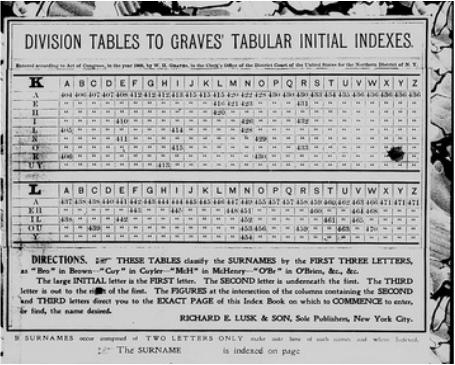 FamilySearch.org - Deeds (Erie County, New York), 1808-1927; index to deeds, 1808-1964 - Deed index-grantee 1893-1897 vol 5, K-Z, image 4 of 665 FamilySearch.org - Deeds (Erie County, New York), 1808-1927; index to deeds, 1808-1964 - Deed index-grantee 1893-1897 vol 5, K-Z, image 4 of 665 County record for things like deeds, probate records and others often have the surnames somehow indexed to make it easier to find them. Rarely are these indexes a straight alphabetical sorting, however. When you begin to research in a particular record set in a particular location, spend a few minutes familiarizing yourself with how the index works. Those few minutes will save you time in the long run. This rule applies whether you are searching an actual roll of microfilm at a family history center or browsing the digitized images of these records on FamilySearch.org. A case in point involves the deed indexes for Erie County, New York. Many of these records have been digitized by FamilySearch.org. They are not necessarily searchable, but they are browsable. I was recently looking for a deed in which James Lawson purchased some property in Buffalo, Erie, NY. Erie County uses the Graves Tabular Initial Indexes for its land records. These tables classify surnames by the first three letters. In my case I was looking for LAW for Lawson. As the image below shows, I use the table for “L”. I find the second letter, “A” under the bold “L”, and then follow across until I see “W.” In the “A” line under the “W” is the number 466. I will find all entries for Lawson on page 466. If I were looking for Lewis, those entries would be on page 468. I then need to scroll forward to find page 466 for my Lawson entries. There may be multiple pages numbered 466, depending on how many Lawson, Lawrence, Lawlor, etc. transactions there are for the time frame covered by the index. Once you find page 466 in the grantee index, you can see there are 6 columns representing the first letter of the grantee’s given name. ABCD appear in one column, EFGH in another. It’s a simple matter to scan down the IJKL column until I see a J and then look to the right to see if that is a transaction for James Lawson. If there is a transaction for James, I write down the Liber (Book) and Page numbers. It is an easy matter then to find the Deeds Volume for the Liber number shown on the index, and then find the right page and, voila! there’s the deed I want. I have found that in a particular set of indexes, the tables hold constant across the years and between grantor/grantee. If I find that Lawson will be found in the index on page 466 for Grantees in Erie County in 1885, Lawson will also be found on Grantors in 1840 in the same set of land records. I don’t need to look it up every time. Here’s a tip – if you have a lot of a particular surname in an area, make note of their page number for the index. You won’t have to look it up every time you’re working on deed research. One more tip – sometimes the index tables cover several letters – J,K,L&M. The microfilm, or digitized film might be A-K and L-Z, so to find your table for L, you might have to go to the start of the J’s. And if you can’t find for your year in the grantee index, look for the table for a different year or in the grantor index – because the tables work across time and grantor/grantee, it will still work.
There are several other types of indexes besides the Graves Tabular Initial Index. I will cover others in upcoming Technique Tuesdays blog posts. |
AuthorMary Kircher Roddy is a genealogist, writer and lecturer, always looking for the story. Her blog is a combination of the stories she has found and the tools she used to find them. Archives
April 2021
Categories
All
|
